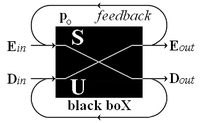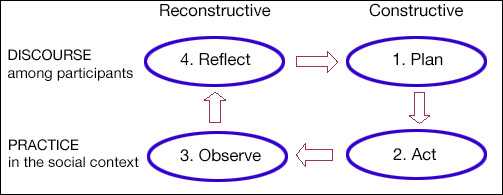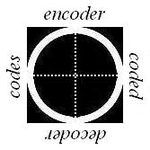Literature/1996/Pemberton
< Literature < 1996| Authors | ||
|---|---|---|
|
A B C D E F G H I J K L M N
|
| |
Authors
Excerpts
- Someone interested in HCI reads the SIGCHI Bulletin, but apparently only someone involved in SIGCHI knows how to pronounce it, [c 1] and that's why we chose Archive as the title for this issue, so that everyone would know. CHI is pronounced like the chi in archive. [c 2]
- This issue marks the start of ACM's 50th Anniversary year, and to celebrate the start of the year this issue features a look back at the history of SIGCHI. Ever wondered how come there have been 27 volumes of the SIGCHI Bulletin, while HCI didn't even come into existence before 1980? Read on....
- ... during [the late 70's], a growing number of people became concerned about the human interaction of computer systems. The need for "people-oriented" systems, which reflected the needs and behavioral characteristics of the user population, became a matter of major interest to the computing profession.
- The ACM itself recognized the importance of the user interface when it scheduled Allen Newell to be an invited speaker at the Computer Science Conference in February 1982. Professor Newell's topic: "Human Interaction with Computers: The Requirements for Progress." [c 3]
- Between 1978 and 1982, we lobbied for a name change from SIGSOC to SIGCHI.
- "In every journal, in every discussion these days, we hear that systems aren't being used as the designers envisioned: it is time to emphasize research directed towards the users. The days of computer-oriented people are passing: the new era must lead towards people-oriented computers." (L. Borman, SIGSOC Bulletin, Spring 1978, Volume 9)
- Again, in the July 1978 Bulletin, 10,1, Borman wrote "we want to give special focus to the human factors in computing, such as through studies of user's reactions to current systems, review of methods for assessing differences in the human results, and discussions of the theoretical basis for these performance differences."
- CHI '95 received 228 submissions, 66 of which were accepted, leaving 162 rejected submissions. Each paper received evaluations from between four and nine reviewers .... Each paper is assigned to an associate chair (AC), who writes a "meta-review." ACs are intended to summarize the reviewers' comments, perhaps weighting those comments differently depending on their judgement of the seriousness of the criticisms. ACs are also free to add their own opinions to the meta-reviews. [c 4]
Wikimedia
Chronology
- Grudin, Jonathan (2011). "Human-Computer Interaction," in: Cronin, B., ed. (2011), Annual Review of Information Science and Technology 45: 369-430. [+]
- Reagle Jr., Joseph Michael (2010). Good Faith Collaboration: The Culture of Wikipedia. MIT Press. [+]
- Lesk, Michael (2005). Digital Searching to Digital Reading. Presentation at LITA session at American Library Association conference, Chicago, 2005. [+]
- Literature/2001/Wales [+]
- Literature/1997/Grudin [+]
- Campbell-Kelly, Martin & William Aspray (1996). Computer: A History of the Information Machine. Basic Books. [+]
- Pemberton, Steven, ed. (1996). SIGCHI Bulletin Vol.28 No.1, January 1996, ACM. [+]
- Cunningham, Ward (1995). WikiWikiWeb. Portland Pattern Repository, Cunningham & Cunningham, Inc. http://c2.com/cgi/wiki [+]
- Literature/1994/Olsen [+]
- Literature/1990/Berners-Lee [+]
- Literature/1989/Berners-Lee [+]
- Literature/1989/Bates [+]
- Literature/1989/Brown [+]
- Literature/1989/Clark [+]
- Literature/1989/Horn [+]
- Literature/1989/Mackinlay [+]
- Adler, Mortimer J. & Geraldine van Doren (1988). Reforming Education: The Opening of the American Mind. New York: Macmillan. [+]
- Literature/1988/Marchionini [+]
- Literature/1988/Radecki [+]
- Literature/1987/Conklin [+]
- Literature/1987/Suchman [+]
- Literature/1986/Norman [+]
- Literature/1984/Grudin [+]
- Literature/1984/Trigg [+]
- Anderson, John Robert (1983). The Architecture of Cognition. Harvard University Press. [+]
- Literature/1983/Barwise [+]
- Literature/1983/Carbonell [+]
- Literature/1983/Card [+]
- Literature/1983/Dervin [+]
- Literature/1983/Gardner [+]
- Gentner, Dedre & Albert L. Stevens, eds. (1983). Mental Models. Lawrence Erlbaum Associates. ISBN 0-89859-242-9. [+]
- Philip N. Johnson-Laird (1983). Mental Models: Toward a Cognitive Science of Language, Inference and Consciousness. Harvard University Press. [+]
- Literature/1983/Laird [+]
- Literature/1983/Rumelhart [+]
- Shneiderman, Ben (1983). "Direct Manipulation: A Step Beyond Programming Languages," Computer, Vol. 16, No. 8 (August 1983) pp. 57-69. [+]
- Trigg, Randall Hagner (1983). A Network-based Approach to Text Handling for the On-line Scientific Community. Doctoral Dissertation, University of Maryland, College Park, MD. [+]
- Literature/1983/Winograd [+]
- Literature/1983/Young [+]
- Literature/1982/Brown [+]
- Literature/1982/Capra [+]
- Literature/1982/Foley [+]
- Literature/1982/Grudin [+]
- Literature/1982/Miller [+]
- Literature/1982/Naisbitt [+]
- Literature/1982/Olsen [+]
- Literature/1982/Revans [+]
- Literature/1982/Russell [+]
- Weyer, Stephen A. (1982). Searching for Information in a Dynamic Book. Ph.D. dissertation, Dept. of Education, Stanford University, February 1982. [+]
--------------- discontinuity ---------------
- Literature/1980/Berners-Lee [+]
- Smith, Linda Cheryl (1980). "'Memex' as an image of potentiality in information retrieval research and development." Proceedings of the 3rd annual ACM conference on research and development in information retrieval (SIGIR '80, Cambridge, England, 1980) Kent, UK: Butterworth, 1981. pp. 345-369. [+]
- Soergel, Dagobert (1977). "An Automated Encyclopedia: A Solution of the Information Problem?" International Classification, 4(1): 4-10; 4(2): 81-89. [+]
- Belkin, Nicholas J. & Stephen E. Robertson (1976). "Information Science and the Phenomenon of Information," Journal of the American Society for Information Science (Jul-Aug 1976) 27 (4): 197-204. [+]
- Nelson, Ted (1974). Computer Lib/Dream Machines. [+]
Comments
 A self-referential or second-order cybernetic information model of system-user interaction (sui). The system S casts D as the user U does E, which are crossed, hence CHI or human-computer interaction, in a way. |
 Gregory Bateson and Margaret Mead contrasted first and second-order cybernetics with this diagram in an interview in 1976/Bateson. |

Le Moigne (1990) may regard the left-hand side as the system or computer as the source of information, and the right-hand side as the user or human as the source of organization.

Compare this process with the Le Moigne model above:
- plan -- organized
- act -- organizing
- observe -- informed
- reflect -- informing

The four quadrants similar to the 4-stroke engine cycle:
- suction -- plan
- compression -- act
- explosion -- observe
- exhaustion -- reflect.
- ↑ It need be made clear who on earth is most responsible that "only someone involved in SIGCHI knows how to pronounce it" that sounds like a conspiracy!
- ↑ The Greek alphabet "X" is called chi sounding as in archive. The cross-shaped "X" suggests the system-user interaction (SUI) or computer-human interaction (CHI), also known as human-computer interaction (HCI) sounding more "human-centered" or "user-centered". Including Bateson & Mead (1976), some believe this perspective is revolutionary in cybernetics. The existing ACM SIGSOC was redefined as SIGCHI in 1982 nearly coinciding with the founding of Cognitive Science Society in 1979, reflecting the cognitive revolution proper! See also the above diagram.
- ↑ Along with Marvin Minsky of MIT, Allen Newell and Herbert Simon of CMU were essentially a man of dehumanizing "strong AI" or cognitivism so as to be focally attacked by Hubert Dreyfus and John Searle of UC Berkeley. The cognitive revolution proper since the late 70's, coupled with the AI winter asked them of a vital paradigm shift for survival. In this perspective, CHI is sharply contrasted with AI. It was a strange case that Doug Engelbart of the ARC and among the 2002 CHI Academy inductees was replaced around 1975 with Minsky's student Bertram Rafael of AI.
- ↑ Justice would seriously matter especially in the batch process of peer reviews in contrast to the interactive and iterative process. They could do harm to scientific revolutions and progresses by being abused by academic partisans and incommensurable paradigms as noted by Thomas Kuhn (1962). Refer to "Control of Abuses" (pp. 298-301) of JD Bernal (1939).
Notes
This article is issued from Wikiversity - version of the Tuesday, September 30, 2014. The text is available under the Creative Commons Attribution/Share Alike but additional terms may apply for the media files.
